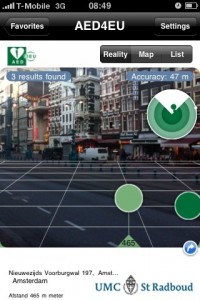Yesterday I posted a video in which Lucien Engelen (@zorg20) interviewed me about social media in healthcare, which he shot while I was his guest in the Netherlands earlier this month.
I interviewed Lucien that same day, asking him to tell the story about the mobile phone application for iPhone and Android that he had gotten developed and launched. It’s an augmented reality app that shows where the nearest automated external defibrillator (AED) is located, using the phone’s location awareness. In the case of someone experiencing cardiac arrest, the ideal would be for one person to administer CPR while another bystander uses a smart phone to locate an AED that could shock the heart back into normal rhythm.
I could talk more about the application, but Lucien demonstrates it briefly in this video. More importantly, he tells the story of how Twitter enabled him to find a programmer to get the project done, and how much time that saved in development.
Twitter is an amazing tool for finding information, but more importantly making connections with people. Three weeks from first Tweet to completed iPhone application is pretty amazing. In the way of the Web 1.0 world, Lucien’s analysts would have had to identify a list of companies with programming capability, build a list and then send candidate companies a request for proposals. In the Twitterverse, he could just tweet the question, directed to no one in particular, and the answer found him in less than 30 minutes.
That’s serious productivity ROI!
How about you? What’s your best story of how Twitter helped you find information quickly?
Update: Here is the AED4.EU site.
